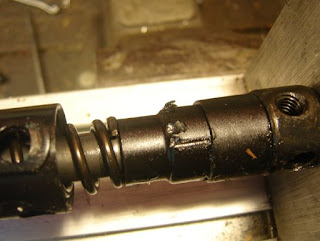My respite from the Crosman 147BP as the epoxy paint dries.
I've had a Crosman Mark 1 pistol for many years. At an airgun show in Findlay, Ohio I ran into the "RB", Ralph Brown, of
RB Grips. You know Ralph--he makes the wood grips for
Crosman's Custom Shop guns. When I saw his selection of grips for vintage Crosmans, I thought of the Mark 1 with it's plastic. A set of "walnut and racing stripe" (as I call them) grips were purchased for not nearly enough money.
**Sidebar: Years ago, I considered making a set of Mark 1 grips. The set-ups and fitting to make a single pair, the other projects in my que, limited free time...man, it's a lot easier to buy the RB's and get a couple days of your life back.
Besides, with the stripe, they're quite different than what I would have typically chosen or made for myself. I know. I really went nuts.

I don't know if the orange colored center wood is osage or perhaps mulberry, but it's an interesting look for a vintage CO2 pistol.

I believe these are the "target" version that RB sells. I wanted the extra material in the grip knowing that I could do some fitting.

The only thing I didn't care for was the high gloss finish. It's a bit too slippery for my taste. It also shows the nicks and dings from handling sooner than an oil finish. I see from RB's website that other finishes--as well as raw--are available.

Slathered the grips with
Strypeez and brass brushed the gloss off. Had bare wood in a few minutes.

Forgot how thick the grip frame is on CO2 guns that house the cartridge in the grip. There's not much extra grip thickness to work with.

With various sizes of sanding drums at the ready, I first focused on the top of the back strap.

Next, I turned my attention to the right grip panel and made a shallow groove for my forefinger.

Finally removed some material at the heel.

Ended up about here. Repeatedly holding the grip and pointing at an imaginary target on the wall will tell you where to remove material.

Don't want to round the base of the grip where it fits flush against the grip frame? Leave the grip on a flat surface (like the top of the workbench) as you sand.

I sanded to 220 grit. I've said it before several times--garnet paper is your best friend for sanding wood. Forget the aluminum oxide paper--that's for sanding metal. It's a pain to try to remove aluminum oxide that's embedded in the wood.

Ready for a finish.

Why not? I've been using a lot of Birchwood Casey Tru-Oil lately. And this pint is darn near full. Shoot, the can even says it's the traditional finish for gun stocks! I can't go wrong.

One down in about 20 seconds.

The boiled linseed oil really brought out the grain.



Hand to gun fit is much better--which always helps on the firing line--and I like the softer look on the wood.
Back to the 147 BP next time around.
























































